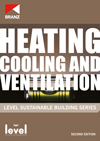Energy
Designing homes to conserve energy and use it efficiently, from sources that cause least environmental harm.
Space heating
Space heating accounts for around a third of energy use in an average New Zealand house, so improving the energy efficiency of space heating has the potential to provide significant economic and environmental benefits.
On this page:
- Key considerations
- How much heating is required?
- Healthy homes standards
- Government grants for heating
Energy consumption for heating and cooling can be reduced in most homes by using passive design features such as correct orientation thermal insulation and thermal mass as well as incorporating effective passive ventilation to maintain indoor air quality. However, even with good passive design, many New Zealand homes will need some form of active heating for at least part of the year.
Key considerations
The key design decisions will include:
- the type of heat required (i.e. radiant or convective) in each part of the house – also see space heating options by room
- the type of heating source (heat pump, electricity, gas, solid fuel or solar), taking account of efficiency, greenhouse gas emissions, pollutants and so on.
- the location, number and capacity of heating units – including whether to use central or room-by-room heating, and whether to use portable or fixed heaters. (Where heating is required for long periods, fixed heaters such as heat pumps and enclosed wood burners are more cost-effective to run than portable heaters.)
- the control systems used – for example, whether to use thermostats, and if so whether to use one thermostat for the whole house or one for each room; in general, heating should be controlled either manually or by thermostat to ensure that heat is only provided where and when it is needed
- how heat is distributed around the building – for example, through natural convection or an active system such as fans or ducts – to ensure spaces are warmed when needed.
Space heating should be discussed early in the planning process to provide the opportunity to place the heat source(s) in the optimal positions in the house.
In general, the aim should be to keep building occupants comfortably warm while minimising energy use (in particular, use of energy that generates harmful emissions). Other major considerations include: fire risk; noise; impact on air quality; cost of installation and use; and life span of the heating source.
How much heating is required?
The World Health Organisation’s Housing and Health Guidelines, published in 2018 (with considerable input from New Zealanders), proposes 18 ˚C as a safe minimum indoor temperature to protect the health of general populations in countries with temperate or colder climates.
Factors that influence indoor air temperature (and occupants’ perceived air temperature) include:
- outside air temperature range
- relative humidity (both outside and inside)
- exposure to direct sunlight (which is warming)
- ventilation air flow (which is cooling)
- stratification (i.e. warm air rising within a space)
- occupants’ activities, ages and personal preferences
- draughts and air leakage, generally in older, less airtight homes.
Active ventilation may help reduce the amount of air that needs to be heated by bringing in warm air from other rooms and/or by creating positive pressure, which prevents cool air from getting into the heated space.
Healthy homes standards
There are specific heating requirements for rental homes in the healthy homes standards that came into force on 1 July 2021. The living room in a rental home must have a fixed heating device capable of achieving a minimum temperature of at least 18°C on cold winter days. (There is an exemption to this requirement for certified Passive House homes.)
In average and larger homes the heater will need to be a heat-pump, wood burner or similar. In small homes a fixed electric heater around 1.5 kilowatts or greater will be sufficient. You can find a tool to help you calculate the heating requirements here.
Inefficient or unhealthy devices or those with very high operating costs will not comply. Unflued gas heaters, open fires and multiple small electric heaters will not comply with the standard.
The healthy homes standards came into force for privately-owned rental properties and boarding houses on 1 July 2021. Owners of rental homes must ensure that their properties comply with HHS within 90 days of any tenancy that starts or is renewed after 1 July 2021. The rules apply to boarding houses immediately. All private rental homes must comply by 1 July 2025. (The Government extended the original date of 1 July 2024.)
In May 2022, the Government made some changes to the heating, ventilation and moisture ingress and drainage standards. One key change enables smaller heating devices to be installed in newer homes built to the 2008 Building Code requirements for insulation and glazing and apartments. You can find more details on this website.
Government grants for heating
Government funding that covers up to 80% of the cost of efficient space heating (up to $3,000 including GST for an efficient wood burner, pellet burner or heat pump) is available for lower-income homeowners. The eligibility requirements are:
- The householder(s) must own the home they live in and it must have been built before 2008.
- The house must have ceiling and underfloor insulation installed to EECA standard (where practicable). There is funding available for insulation too.
- The homeowner must have a community services card or live in an area identified as lower-income.
More information is available on the EECA website.
More information
- www.smarterhomes.org.nz – heating
- www.genless.govt.nz
- www.healthyhousing.org.nz
- www.yourhome.gov.au – energy use
- Healthy homes standards
Updated: 17 April 2023



